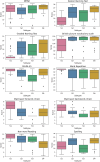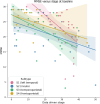Data-driven neuroanatomical subtypes of primary progressive aphasia
- PMID: 39374849
- PMCID: PMC11884653
- DOI: 10.1093/brain/awae314
Data-driven neuroanatomical subtypes of primary progressive aphasia
Abstract
The primary progressive aphasias are rare, language-led dementias, with three main variants: semantic, non-fluent/agrammatic and logopenic. Although the semantic variant has a clear neuroanatomical profile, the non-fluent/agrammatic and logopenic variants are difficult to discriminate from neuroimaging. Previous phenotype-driven studies have characterized neuroanatomical profiles of each variant on MRI. In this work, we used a machine learning algorithm known as SuStaIn to discover data-driven neuroanatomical 'subtype' progression profiles and performed an in-depth subtype-phenotype analysis to characterize the heterogeneity of primary progressive aphasia. Our study included 270 participants with primary progressive aphasia seen for research in the UCL Queen Square Institute of Neurology Dementia Research Centre, with follow-up scans available for 137 participants. This dataset included individuals diagnosed with all three main variants (semantic, n = 94; non-fluent/agrammatic, n = 109; logopenic, n = 51) and individuals with unspecified primary progressive aphasia (n = 16). A dataset of 66 patients (semantic, n = 37; non-fluent/agrammatic, n = 29) from the ARTFL LEFFTDS Longitudinal Frontotemporal Lobar Degeneration (ALLFTD) Research Study was used to validate our results. MRI scans were segmented, and SuStaIn was used on 19 regions of interest to identify neuroanatomical profiles independent of the diagnosis. We assessed the assignment of subtypes and stages, in addition to their longitudinal consistency. We discovered four neuroanatomical subtypes of primary progressive aphasia, labelled S1 (left temporal), S2 (insula), S3 (temporoparietal) and S4 (frontoparietal), exhibiting robustness to statistical scrutiny. S1 was correlated strongly with the semantic variant, whereas S2, S3 and S4 showed mixed associations with the logopenic and non-fluent/agrammatic variants. Notably, S3 displayed a neuroanatomical signature akin to a logopenic-only signature, yet a significant proportion of logopenic cases were allocated to S2. The non-fluent/agrammatic variant demonstrated diverse associations with S2, S3 and S4. No clear relationship emerged between any of the neuroanatomical subtypes and the unspecified cases. At first follow-up, subtype assignment was stable for 84% of patients, and stage assignment was stable for 91.9% of patients. We partially validated our findings in the ALLFTD dataset, finding comparable qualitative patterns. Our study, leveraging machine learning on a large primary progressive aphasia dataset, delineated four distinct neuroanatomical patterns. Our findings suggest that separable spatiotemporal neuroanatomical phenotypes do exist within the primary progressive aphasia spectrum, but that these are noisy, particularly for the non-fluent/agrammatic non-fluent/agrammatic and logopenic variants. Furthermore, these phenotypes do not always conform to standard formulations of clinico-anatomical correlation. Understanding the multifaceted profiles of the disease, encompassing neuroanatomical, molecular, clinical and cognitive dimensions, has potential implications for clinical decision support.
Keywords: atypical dementia; longitudinal; machine learning; phenotype; progression modelling; subtype and stage inference.
© The Author(s) 2024. Published by Oxford University Press on behalf of the Guarantors of Brain.
Conflict of interest statement
The authors report no competing interests.
Figures






References
MeSH terms
Grants and funding
- ES/P000592/1/ESRC-funded UCL, Bloomsbury and East London Doctoral Training Partnership
- 2019-02248/JPND GENFI-PROX
- MR/S03546X/1/UKRI Future Leaders Fellow
- NIHR UCLH Biomedical Research Centre
- Bluefield Project
- Alzheimer's Society, UK
- U01 AG045390/AG/NIA NIH HHS/United States
- BRC149/NS/MH/NIHR Rare Disease Translational Research Collaboration
- Frontotemporal Dementia Research Studentship
- U19 AG063911/AG/NIA NIH HHS/United States
- AS-JF-19a-004-517/ALZS_/Alzheimer's Society/United Kingdom
- Miriam Marks Brain Research UK Senior Fellowship
- MR/M008525/1/MRC Clinician Scientist Fellowship
- U54 NS092089/NS/NINDS NIH HHS/United States
- Royal National Institute for Deaf People
- Alzheimer's Research UK
LinkOut - more resources
Full Text Sources

